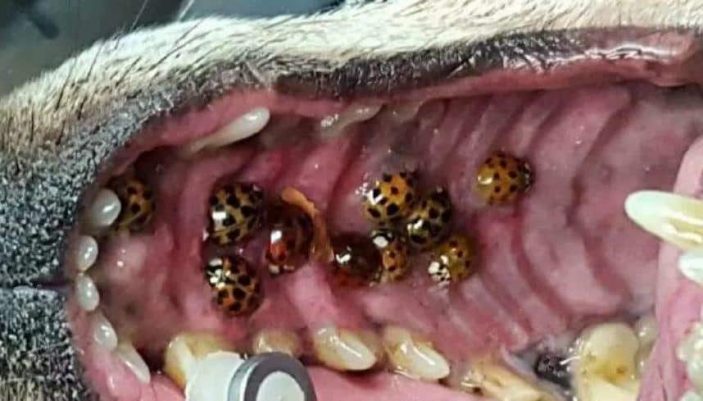The 2016 story of a dog named Bailey that refused to eat, became lethargic only for her vet Dr. Lindsay Mitchell to find this famous bug hunter to be having 30-40 Asian beetles stuck onto her palate (mouth roof) caused an alarm to many dog owners.
The good news is that the vet was able to remove these dead insects and successfully treat Bailey.
If you own a dog that is fond of eating bugs, you must be careful since these specific coccinellids are harmful. Let us have an overview of what these bugs are, how they may affect your dog or what symptoms you will expect as well as something on treatment in case it occurs.
What are Asian ladybugs
To begin with, the incident only involved a certain type of ladybugs, the Harmonia axyridis also known by various names in various places such as multicolored Asian, harlequin, Halloween, Japanese, Southern, multivariate, pumpkin or Asian ladybeetle.

These large beetles (sized 5.5–8.5mm) belong to the family Coccinellidae and comes in varying colors, with 0-19 spots when compared to the nine-spotted ladybug that has 9 spots from North America. Their pronotum is yellow in color and its middle part has black markings.
It is native to Eastern Asia but was introduced to Europe and North America as a means of controlling aphids as well as other scale insects since it preys on them.
Usually, when it is about winter, they invade homes to get warmer places and you will often find them clinging to or hiding on attics, wall voids, suspended ceilings, door and window frames, or any other cracks and voids commonly on the outer areas of houses but they can also move to the inner areas.
This brief overview and image should be able to help you positively identify this insect. Since we have already discussed something on whether ladybugs are poisonous to dogs or not. We will be focusing specifically on the Harmonia axyridis species.
Are Asian ladybugs harmful or poisonous to dogs?
Yes. The Asian ladybeetles are harmful and potentially poisonous or toxic to dogs. You should not allow these pets to eat them. If you are a dog owner, you should not panic since these are not the ordinary ladybugs that are common but rather specific species as we have already mentioned.
Firstly, the yellowish fluid that has an obnoxious smell and taste that these insects release when captured or dying is potentially toxic and harmful. This gooey or mucus liquid is what makes them get stuck on your pooch’s palate instead of being swallowed. Once they are stuck on the roof of your dog’s mouth, they may cause corrosion that mimics a chemical burn, leaving behind ulcers.[1]
Therefore, once they are stuck on the roof of your pet’s mouth, you expect symptoms such as refusal to eat, drooling, drowsiness, lethargy and forming in the mouth. However, if your dog drinks water after eating a few of these coccinellids, they will not be stuck in the mouth but rather go into their stomach.
Inside their stomach, Asian lady beetles can also cause ulceration, diarrhea that may bloodstained, or trigger vomiting among other gastroenteritis signs.
Treatment
If your canine friend has these Asian lady beetles stuck on his or her mouth roof, your vet may require sedation and a tweezer to remove them. You can also do it at home if your dog allows you do to so. A tongue depressor or a spoon can also be used to remove them.
Once removed, the minor wounds left behind will soon heal with some nursing care and medications including antibiotic to prevent secondary infection. Also, “mouthwash containing sucralfate, lidocaine, and diphenhydramine to treat ulcers and reduce discomfort” [2]
Dealing with these ladybugs
To avoid or deal with them, seal voids, cracks, and other entry points in your house. If you notice them inside your house, consider vacuuming them instead of killing them with insecticides since your pets may eat them afterward while they are soaked with these insecticides.
Secondly, “if you notice a loss of appetite, lethargy, and frothy drool in your insect-loving dog, checking the mouth is a good idea”[3] to see if you can see these bugs.
Finally, should you notice these insects around your lawns or garden, consider various methods of keeping them away including the use of pesticides. However, be sure your pets will not eat them afterward. You should not worry you since most vets note that these beetles are not so common.
Conclusion
The instances of Asian ladybeetles reported having affected dogs which munched them are very rare (the encounters are uncommon). The condition is also treatable and should not cause any panic to dog owners.
